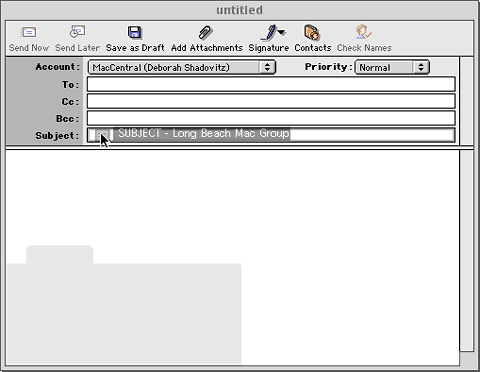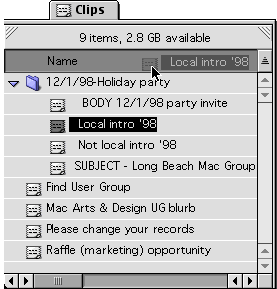|
||||
Make Typing a Real DragWritten and published June 30, 1999 The Mac is about efficiency so of course it's got some typing time-savers built-in. This week I focus on drag-copying and clippings. Picture this:You've hosting an event and need to invite many people. Or you have some major news to tell tons of people. You want to send the word out by email and the message is pretty much the same for all. You just want to add a custom hello on each. What can you do? Here's one way:Create the message once and save it as the master message so to speak. Keep that message open, start and address the first one you want to send. Write a personalized intro if you want, then press return to start a new line. Then select the entire body of the master message and drag that text into the new message body. A dark line like a cursor will show you where the text will land when you release the mouse. After dragging the text, click that document to bring it forward and finish up the message, then save it. Repeat this for each new message. Not a bad method -- if you've just got a few to send. But when you try this you'll see that in order to see where your dragged text is landing you'll want to have both the master and the new message in view. That means resizing the window for every new message you create. Here's the better way:Create the message once. (You don't even have to save it.) Select the redundant text, then drag it onto your desktop. In a moment you'll see a new file appear. On an older system it'll be called a Text Clipping. In any version of OS 8 it'll be named with the first words of your text, ending with "...clipping."
And now the best way:Minimize the typing you do for your custom greeting. As you type a few greetings, consider the redundant parts and make a clipping for each part. Place it beside the other clipping and name it so you know what it is. If you have a few openings make a few clippings. Then, as you create each new message, drag over the pieces that work for that person's note. For example, for a User Group party in 1998 I made a clipping for the subject line. (Today I might set up a TypeIt4Me shortcut instead.) Then I created an intro for local vendors and one for out of town vendors, then a body clipping with the actual party info.
Organizing ClippingsIf this clipping is something you'll use again at another time you rename it more descriptively and save it. And to save it...
Now whenever you need to use a clipping's words, click the pop-up folder and drag the clipping into place on your page.
Other usesText clippings are a long-time favorite of mine, and are well appreciated by those who use them. Yet, most people don't even realize their power - or that they exist. I'm happy to finally be able to share their power. I've provided one example of how you can use text clippings. Try it and you'll see their magic. I'm sure you'll find plenty of uses for them after that. Here are a couple more: You're working on a long document, having a hard time getting the flow down. You can move entire portions out of the document, then delete the text. This gives you a cleaner page on which you can rethink the document. Then you can drag the deleted text into place where it fits. Text clipping use is not limited to these email and word processing examples. They work in any application that is drag-aware. Pictures can be clipped too, and I think sounds too. Try them sometime. One thing to bear in mind, though is that Microsoft really doesn't "get" drag and drop and this is another way it shows. Word 98 clippings don't work the same as full-fledged clippings. When I dragged text out of Word 98 to make a clipping, then dragged it into Adobe GoLive, the clipping came in as a graphic instead of as text. Clippings have been around for years so if you're on a Mac that can connect to the web, chances are you'll find they work in all your programs. Just try and if it works you're set. One Other Drag TrickInstead of taking the steps to copy text (or anything) then paste it, you can select the text (or object) then press Option as you drag. A plus sign appears at the cursor and when you release the mouse you have a copy of the text (or object) in the new place without disturbing the original. This is a great trick for making one copy. If you need to paste the text several times, stick with the copy/paste method. Another time to use Option-drag is when you've got something helpful already copied and don't' want to lose it. Your clipboard remains intact but you also get a quick copy of something else made. Correction and UpdateLast week I misused a term when talking about TypeIt4Me. I called the letters you type as a shortcut to expand your text expansion triggers. The correct word for that can be shortcut, mnemonic, or abbreviation. Riccardo says abbreviation. A trigger is actually the character that tells TypeIt4Me to expand your text - the default being a space. (You can choose another in Preferences.) Also, Riccardo says he'll work on enabling us to have more than one file open at a time. And... he's coming to Macworld so you can meet him at my seminar if you make it there. |
||||

